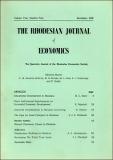| dc.contributor.author | Bone, R.C. | |
| dc.coverage.spatial | Zimbabwe | en |
| dc.coverage.spatial | Rhodesia | en |
| dc.date.accessioned | 2015-08-14T11:07:42Z | |
| dc.date.available | 2015-08-14T11:07:42Z | |
| dc.date.issued | 1968-12 | |
| dc.identifier.citation | Bone, R.C. (1968) Educational Development in Rhodesia. Rhodesia Journal of Economics (RJE) vol. 2, no.4 (pp. 5-28.) UZ (formerly University College Rhodesia), Harare (formerly Salisbury) : RES. | en |
| dc.identifier.uri | https://opendocs.ids.ac.uk/opendocs/handle/20.500.12413/6731 | |
| dc.description | A RJE article on the history of educational development in Rhodesia from the formative years. | en |
| dc.description.abstract | The first mission station established in what is now Rhodesia was the L.M.S. venture at Inyati in 1859. It was not until nearly 30 years later that a second missionary group entered the country (the Roman Catholics at Empandeni). Throughout the period of Matabele independence and dominance—until the European occupation in 1890—the efforts of the missionaries to evangelize and educate were almost total failures.
It was only with the European occupation that first in Mashonaland and then, from 1893, in Matabeleland there was a strong inflow of missionary societies and a rapid extension of activity in the fields of evangelization and education.
The first measure of Government participation was taken in 1899 with the promulgation of an Education Ordinance, establishing a system of grants-in-aid and the skeleton of an Education Department to administer it.
Over the years the system was developed and the administration strengthened. The Education Department, however, was “charged principally with the oversight of European schools”1 2 3 4 and only from the beginning of 1928 was a separate Native Education Department set up. Under the Native Development Act of 1929 the department was renamed the Department of Native Development and its functions appropriately widened to include agricultural and community development. Tensions between it and the Native Affairs Department built up and in 1933 the Native Development Department was broken up and its various components brought under the Native Affairs Department and so under the Chief Native Commissioner.
Only in 1956 was education again separated off and an “untrammelled”* department of Native Education established.
Throughout this entire period (1890-1956), although government increasingly exercised control of African education and increasingly aided it, its provision was almost entirely in the hands of the missions.
Two specialist Government training schools (Domboshawa and Tjolotjo) were opened in 1920 and 1921. Tjolotjo had a difficult and troubled history and in the early 1940s was transferred to a new site near Bulawayo and given a new name—Mzingwane. | en |
| dc.language.iso | en | en |
| dc.publisher | Rhodesian Economic Society (RES). University of Rhodesia (now University of Zimbabwe.) | en |
| dc.rights.uri | http://creativecommons.org/licenses/by-nc-nd/3.0/ | en |
| dc.subject | Development Policy | en |
| dc.subject | Education | en |
| dc.title | Educational Development in Rhodesia | en |
| dc.type | Article | en |
| dc.rights.holder | University of Zimbabwe (UZ) (formerly University College of Rhodesia) | en |


